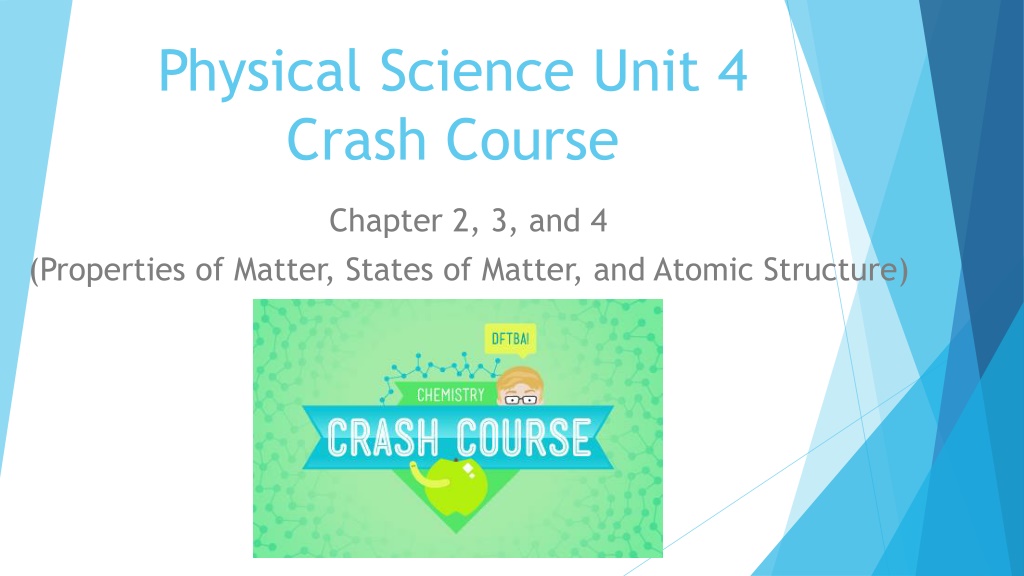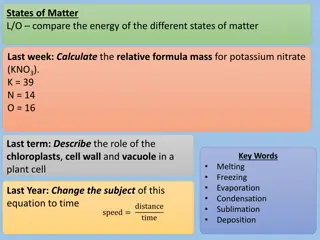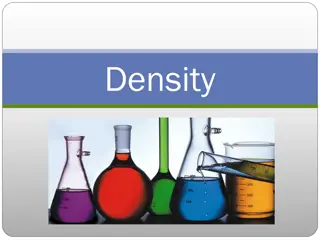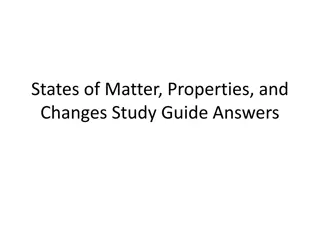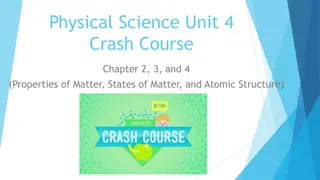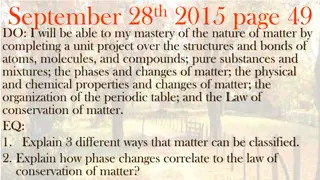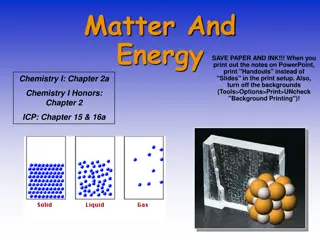Understanding Properties and States of Matter in Physical Science
Matter is made up of elements that cannot be broken down further. Different mixtures have distinct properties, such as solutions, colloids, and suspensions. Physical properties like viscosity and density can be observed without changing the material's composition. Chemical properties, like flammability, cause changes in matter's composition. States of matter include solid, liquid, and gas, each with unique characteristics.
Download Presentation

Please find below an Image/Link to download the presentation.
The content on the website is provided AS IS for your information and personal use only. It may not be sold, licensed, or shared on other websites without obtaining consent from the author. Download presentation by click this link. If you encounter any issues during the download, it is possible that the publisher has removed the file from their server.
E N D
Presentation Transcript
Physical Science Unit 4 Crash Course Chapter 2, 3, and 4 (Properties of Matter, States of Matter, and Atomic Structure)
Chapter 2 - Matter An element is a substance that cannot be broken down into simpler substances. An atom is the smallest particle of an element. Each element symbol is either one or two letters. The first letter is always capitalized. If there is a second letter, it is lowercase. A compound always contains two or more elements joined in a fixed proportion. The properties of a mixture can vary because the composition of a mixture is not fixed.
Chapter 2 - Matter Based on the size of its largest particles, a mixture can be classified as a solution, a suspension, or a colloid. Properties of solutions: small particles, do not settle, cannot be filtered, allow light to pass through, and have small particles. Properties of colloids: medium particles, do not settle, cannot be filtered, scatter light, and have medium-sized particles. Properties of suspensions: large particles, settle over time, can be filtered, scatter light, and have large particles.
Chapter 2 - Matter A physical property is any characteristic of a material that can be observed or measured without changing the composition of the substances in the material. Viscosity, conductivity, malleability, hardness, melting point, boiling point, and density are examples of physical properties. Filtration and distillation are two common separation methods. Filtration is a process that separates materials based on the size of their particles. Distillation is a process that separates the substances in a solution based on their boiling points. A physical change occurs when some of the properties of a material change, but the substances in the material remain the same. Physical changes can be reversible or irreversible.
Chapter 2 - Matter A chemical property is any ability to produce a change in the composition of matter. Flammability and reactivity are two examples of chemical properties. A chemical change occurs when a substance reacts and forms one or more new substances. Three common types of evidence for a chemical change are a change in color, the production of a gas, and the formation of a precipitate. Any solid that forms and separates from a liquid mixture is called a precipitate.
Chapter 3 States of Matter Solid is a state of matter in which materials have a definite shape and definite volume. Liquid is a state of matter in which a material has a definite volume but an indefinite shape. Gas is the state of matter in which a material has an indefinite shape and an indefinite volume. Plasma is a state of matter composed of positive ions and electrons.
Chapter 3 States of Matter Collisions between particles of a gas and the walls of the container cause the pressure in a closed container of gas. Factors that affect the pressure of an enclosed gas are its temperature, its volume, and the number of its particles. Charles law states that the volume of a gas is directly proportional to its temperature in Kelvin if the pressure and the number of particles of the gas are constant. Boyle s law states that the volume of a gas is inversely proportional to its pressure if the temperature and the number of particles are constant.
Chapter 3 States of Matter Melting, freezing, vaporization, condensation, sublimation, and deposition are six common phase changes. The temperature of a substance does not change during a phase change. During an endothermic change, the system absorbs energy. During an exothermic change, the system releases energy to the surroundings.
Chapter 4 Atomic Structure Thomson concluded that the particles in the cathode ray have a negative charge, and he called them electrons. Since atoms are neutral, Thomson s model shows a positively charged area with electrons scattered throughout. This model is known as the plum pudding model. Rutherford shot alpha particles at a gold foil. This led Rutherford to the conclusion that there was a dense positive charge in the center of the atom and that most of the atom is empty space.
Chapter 4 Atomic Structure Protons, electrons, and neutrons are subatomic particles. Subatomic Particle Relative Mass Charge Location proton +1 1 nucleus neutron 0 1 nucleus electron cloud electron -1 1/1840
Chapter 4 Atomic Structure The atomic number of an element equals the number of protons in an atom of that element. Atoms of different elements have different numbers of protons. So the atomic number of an element also equals the number of electrons in an atom. The mass number of an atom is the sum of the protons and neutrons in the nucleus of that atom. Number of neutrons = mass # atomic #
Chapter 4 Atomic Structure Isotopes are atoms of the same element that have different numbers of neutrons and different mass numbers. Isotopes are referred to in the following way: carbon 12, carbon 13, and carbon 14 where the numbers are the mass numbers. Some isotopes are written in the shorthand shown to the right where the top number is the mass number and the bottom number is the atomic number.
Chapter 4 Atomic Structure In Bohr s model, the electrons move with constant speed in fixed orbitals around the nucleus. The possible energies that electrons in an atom can have are called energy levels. If an atom gains or loses energy, the energy level of an electron can change. Each energy level can hold a maximum number of electrons. Max Number of Electrons Energy Level 1 2 2 8 3 18 4 32
Chapter 4 Atomic Structure When all the electrons in an atom have the lowest energy possible, the atom is said to be in its ground state. If one or more electrons have jumped to higher energy levels, the atom is said to be in its excited state. The movement of electrons between energy levels explains the light you see when fireworks explode. Light is a form of energy.
